If people do not like your website, Google has no reason to rank it high. The search engine’s goal is to offer the best possible results for users.
This is where the bounce rate steps in. It is a vital SEO metric that has to be taken into account in every single SEO strategy created.
A failure to do this will lead to sub-par results.

This is one of the best quotes about SEO you will ever read and it is the foundation of how you need to approach search engine optimisation!
The problem is that bounce rate is underrated by so many SEO specialists. Many other factors are prioritized during SEO audits and this needs to stop.
When your bounce rate is low, you are doing something wrong. Google will NOT rank you as high as you want and your conversion rate is surely way lower than it could be.
So, what exactly is bounce rate? How does it affect your SEO campaigns and what is a good bounce rate to target? Let’s answer these questions and learn more about Google’s most underrated ranking factor.
- What Is Bounce Rate?
- Why Should You Care?
- What’s The Difference Between Bounce Rate And Exit Rate?
- What Is An Ideal Site Bounce Rate?
- When Is A High Bounce Rate Normal?
- How To Reduce Bounce Rate - Actionable Strategies That Work
- Reduce Page Loading Time
- Use Time On Site To Determine The Real Cause Of A High Bounce Rate
- Be Smart With Formatting
- Implement A Useful And Logical Structure For Internal Links
- Optimise Your Site For Mobile Users
- Add A Compelling CTA
- Use The Best Target Keywords To Attract The Best Audience
- Take Advantage Of User Intent To Create Relevant Content
- Remove Sidebars When They Are Not Necessary
- Conclusions
What Is Bounce Rate?
Google offers the following definition for bounce rate:
By bounce, we mean a single-page visit on a site.
Basically, bounce rate is a percentage. It shows you how many of your visitors did nothing on the web page they visited.
Example:
Let’s say 10 people visit your homepage. One clicks on a link to learn more about your services and another one clicks on the contact page to send you an email. The other 8 click the “Back” button of their web browsers or close the tab.
In this case, 8 people out of 10 did nothing ON your site. As a result, your bounce rate is 80% and it is quite horrible.
Why Should You Care?
To keep things simple, bounce rate is very important in the world of search engine optimisation because of 3 main reasons:
- When a person bounces, there is no conversion. This means that if you manage to stop the bounce, there is a higher possibility to increase website conversion rates.
- Bounce rate is actually an underestimated Google ranking factor. You should know that there was an industry study that proved the fact that first page rankings are strongly correlated with it.
- Whenever there is a high bounce rate present, you know that the website has issues with user experience, content, copywriting, or page layout.
What’s The Difference Between Bounce Rate And Exit Rate?
There are similarities between bounce rate and exit rate so it is normal to confuse the two terms.
The big difference is that bounce rate refers to a percentage of those that land on one of your pages and then leave. The exit rate is a percentage that counts people that leave from one specific page. It does not matter where on your site the visitor initially landed.
Example:
Let’s say John lands on your website, on page A. Then, he hits the back button because of whatever reason. This is 100% a bounce.
Now, let’s say John lands on your website, on the same page A. He likes what he sees and then clicks to visit page B. After he goes through the content on page B, he closes the browser tab. This is marked as an exit on page B.
What Is An Ideal Site Bounce Rate?
This is not a very easy question to answer because there are countless legitimate reasons why bounce rate could be high. However, generally speaking, we can highlight the following categories:
- Perfect Rate – Under 40%.
- Good Rate – Between 40% and 55%.
- Needs Improvement – Between 55% and 65%.
- Needs Serious Improvement – Between 65% and 90%.
- Error – When the bounce rate is over 90% or under 20%, there is a huge possibility there is a code or tracking installation error present.
Keep in mind this should just be seen as a rule of thumb. It is sometimes normal to have a higher bounce rate than the figures mentioned above.
The most important factors that influence bounce rate are:
- Traffic type – Do visitors look exactly for your firm or do they need information? Those that are familiar with your brand are going to bounce less when compared to those just looking for information.
- Traffic source – Those that come to your site after a Google search tend to bounce a lot less than those coming from social media. This is just an example and the key here is to analyze different traffic sources to analyze all of them to see the rates for every channel.
- Website layout and design – If the website is very difficult to navigate, looks old-fashioned, or is confusing, bounce rates will be a lot higher.
- Where the visitor lands – There is normally a higher bounce rate on a blog article than on a service page. Also, if visitor land on the homepage, bounces tend to be lower.
- Message clarity – People are easily distracted and busy. When they think they will not be able to find the answer they look from or they simply do not see signs that this will happen, they will leave. Out of all the causes of high bounce rate, this is the one that is the most underrated. Also, it is a part of why very good copywriters are paid a lot of money.
- Website usability and speed – It is completely normal for a website that loads slowly to have a very high bounce rate. Also, conversion rates tend to be low. Even Google will tell you that 53% of visitors using a mobile device will leave the site that loads in more than 3 seconds.
The last thing that should be mentioned about having an ideal bounce rate is that the industry the site operates in has an impact on this metric. To better highlight this, take a look at the following chart from Digishuffle.
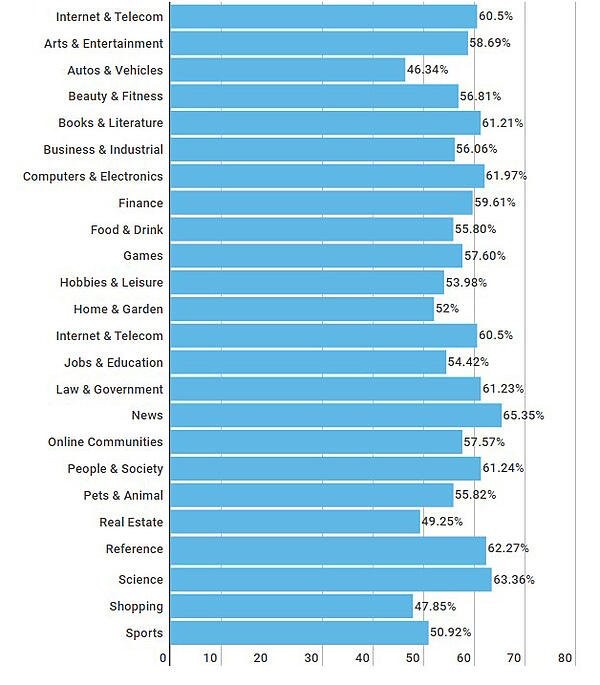
As you can see, there are huge differences between averages when comparing different industries.
When Is A High Bounce Rate Normal?
While for most websites a high bounce rate is a sign that something is seriously wrong, there are situations when this is not the case. This is why we also have to discuss context.
Google Analytics says:
Not all sites have the goal of getting as many page views as possible.
For instance, bounce rate is usually not relevant to websites that have one page, news sites, and even many blogs.
There are also situations where a higher rate is actually a good sign. As an example, this might indicate that the visitor finds what he/she needs on one page, like business hours or contact information.
Let’s also think about another example.
Let’s say you write a review about a book and you publish it on your blog. Then, the post performs really well and shows up high in search engines. When someone visits the review page, he/she gets all that is desired. If you do not sell the book and you just wrote a review about it, the higher bounce rate can be normal because the visitor reads the review, which is what was intended. (read more about user intent below)
How To Reduce Bounce Rate - Actionable Strategies That Work

Before we talk about what you can do, you should be aware of the fact that reducing bounce rate is not easy. You have to identify why the rate is low and then make several changes. In numerous cases, this will only be possible with a large financial investment.
The tricky part is figuring out why the rate is high. With this in mind, here are some strategies that you have to consider.
Reduce Page Loading Time
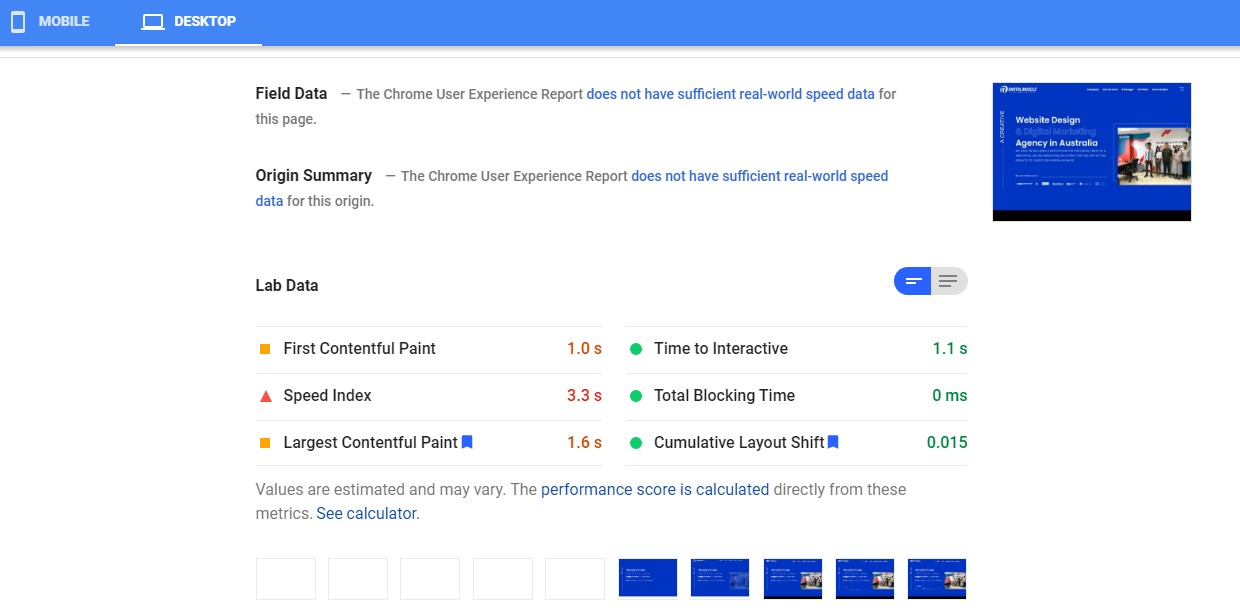
The initial assumption when the bounce rate is too high is that there is some sort of problem with the content. In reality, in most cases, there is a serious problem that appears before users read the first word on your pages.
Nowadays, the internet is faster than ever and people are used to the speed. They want websites to load in seconds. If this does not happen, they leave.
What is particularly important is to think about mobile users. Radware published a very interesting report about web performance you should read. What is important in this case is that a 500 milliseconds delay leads to a loss of engagement of eight percent and an increase in user frustration of 26%.
We can mention countless statistics but the bottom line here is that your site needs to load as fast as possible. Only after you optimise page load speed you can think about doing something else.
Use Time On Site To Determine The Real Cause Of A High Bounce Rate
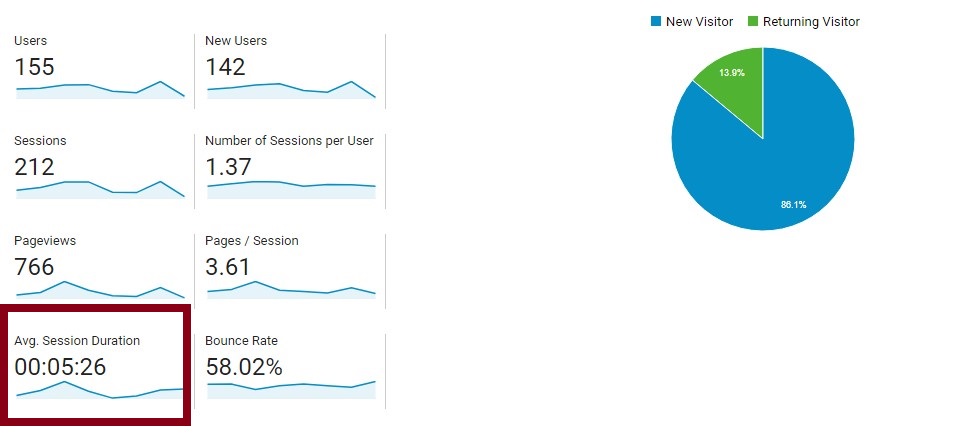
It is a very bad idea to only look at bounce rate when you analyse your website. This is not the only indicator of performance.
You need to determine why the rate is high, and although this is done in various ways, a critical metric to take into account is time on site. (represented as Avg. Session Duration in Analytics) This helps you determine if you are dealing with a site-wise problem or there is something else that causes the increase, like a page type or even a single page.
As an example, when you see that time on site is good and you identify the blog pages having a higher bounce rate, there is a big possibility your content is the problem. If time on site is low and the bounce rate is very high, you most likely do not deliver what visitors want.
An extra thing to consider:
Always investigate several usage trends before you make a decision that will affect the entire site. It is very easy to get stuck on one bad metric and make things worse by optimising something that should not have been changed.
Be Smart With Formatting

You surely clicked on a link or search result and landed on a page with a huge wall of text. Did you stay to read it or did you just click the back button?
You can create very good content that is unique and valuable and it will not matter when readers just want to leave because of how large the text looks.
This is where formatting steps in to give a huge helping hand.
Make sure that your pages are as formatted as possible so they become accessible and welcoming. This is actually one of the best possible ways to reduce the website bounce rate.
The principle is very simple: make the pages as inviting for the visitors as possible so there is a much higher possibility of sticking around. Make your content less intimidating by:
- Appropriately using headers
- Using suitable images for your content
- Frequently using subheadings
- Using numbered and bulleted lists
You might have heard this several times before but the goal is to make it very easy for the visitor to skim the content. He/she needs to quickly identify the relevant points and get to them.
At the same time, make sure that you do not overdo it. Only use such formatting options when they make sense.
Implement A Useful And Logical Structure For Internal Links
Read 20 articles about how to reduce bounce rate and you will see this tip in most of them: “include as many internal links as possible”.
This is a VERY BAD approach to using internal links when it comes to both search engine optimisation and increasing usability.
The reason why this strategy works is that there are so many extra internal links added that there is a very high possibility that the second click will be recorded in Google Analytics. This means that there won’t be a bounce but user experience is drastically reduced when you use such a strategy.
Let’s take a look at this screenshot from Wikipedia:

In this case, those links make sense because we are talking about an encyclopedia. However, if the same internal linking structure would be used on a blog or a business site, it will simply cause huge readability issues.
When you add internal links, make sure that they expand on the topic that is being discussed. Also, when you link out, make sure that you link to sources that would do the exact same thing.
On most websites, when you overdo it with internal links, like in the Wikipedia example above, you dissuade the visitors from clicking them.
Optimise Your Site For Mobile Users

It can quickly become frustrating to keep hearing about optimising websites for mobile users. It seems that this is the solution for practically anything these days.
But,
The truth is that it is so incredibly important that we need to also mention it here.
Most websites are not optimised for mobile users. This is a huge problem since the number of mobile users keeps growing. When one of them lands on your site and it takes too long to load, there is a huge possibility a bounce will happen.
The problem is that it is usually difficult to launch a mobile-friendly website. This is especially the case when referring to larger sites. The whole process can be very expensive.
Even so, we cannot understate how vital mobile optimisation is for literally any website today. You NEED to do all you can to make your site as optimised for mobile users as possible.
Add A Compelling CTA

The official recommendation coming from most professionals is to add a very clear and compelling call to action (CTA) to every single one of your page. This is a very good idea but you need to be aware of the fact that some CTAs can increase bounce rate. At the same time, there are numerous situations in which a CTA is not a good idea for the page.
Statistics show us that 70% of small business websites do not have a CTA. This is very bad for such a site because it is the CTAs that guide the visitor. However, when referring to most blogs, the use of CTA should be more limited.
If you do not have a CTA on your pages, you need to determine if using one is a good idea. If so, you need to add just ONE and make it good.
When you have CTAs on pages, you have to test them so you are sure they are really good.
The best CTA needs to be:
- Prominent – The best position for the call to action is above the fold. Only duplicate it below this area if it makes sense.
- Clear – You need to tell your visitor what will happen when the button is clicked (like getting a free quote, signing up, or buy something).
- Relevant – It should prompt the user to take the next step you want him/her to.
Also, the CTA has to stand out and use commanding words.
Use The Best Target Keywords To Attract The Best Audience
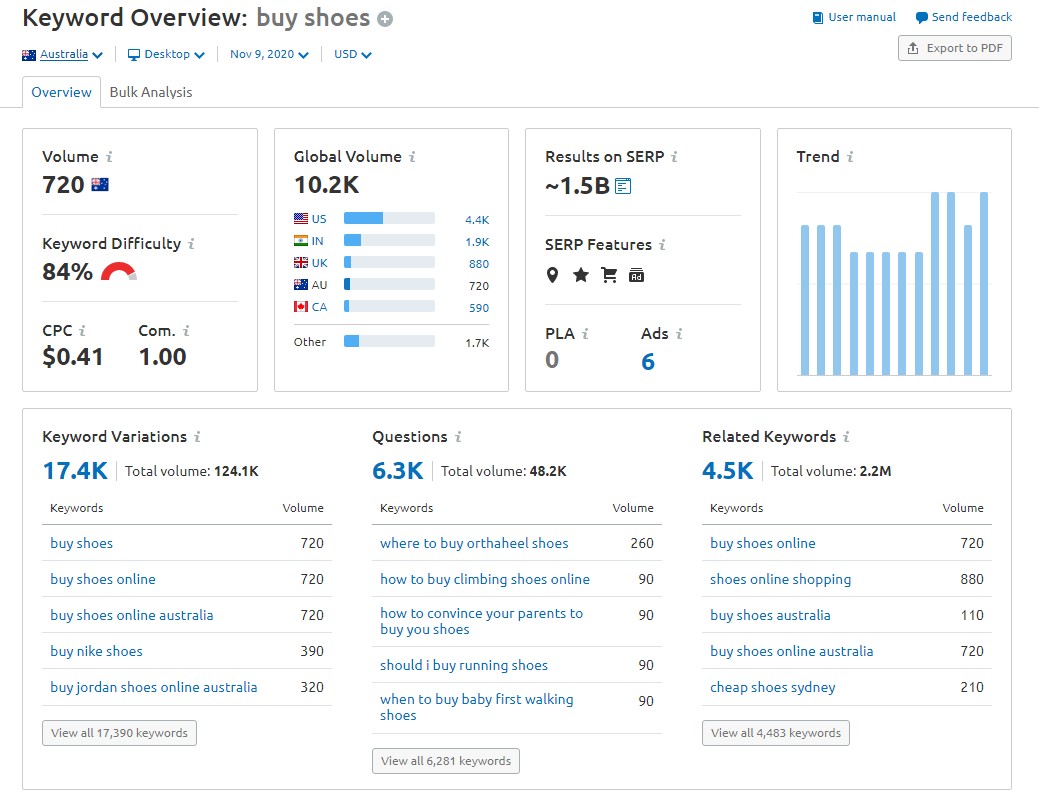
It is very common for sites to target an inappropriate audience. This always leads to a high bounce rate because the visitors that are gained are of low quality for the website. Engagement will always be low and the same thing can be said about conversions.
Analyse the bounce rate on the site and see if there are signs that targeting is off.
When content is created, you want to attract the highest quality traffic possible. You can only do this when you use the right keywords.
Unfortunately, there is a lot to be said about how to create power pages and in-depth content. It is also difficult to find keywords with the highest value. However, it is very important if you want to reduce bounce rate.
If you want to learn how to choose the best possible keywords, Backlinko has the following great guide:
Take Advantage Of User Intent To Create Relevant Content

When you target the best audience, choose very good keywords, and bounce rate is still too high, there is a good possibility the problem is how relevant the content is.
The visitor that comes from Google uses a specific query. When he lands on your page, he/she looks for something specific. It is a certainty the user will bounce when the content is not relevant.
The good news is it is easy to create very relevant content. When someone looks for a Korean wings recipe, you have to offer a Korean wings recipe. The bad news is it is more difficult to understand how to properly use user intent.
Google users look for various content types based on the place in the buyer’s journey they are in. 4 types of user intent exist:
- Transactional
- Informational
- Commercial investigation
- Navigational
To better understand this, when the visitor is in an awareness stage, he/she looks for informational content. For instance, there might be a desire to find a how-to guide. If this is the case, you need to create a piece of content that is informational and relevant. If you try to pitch a service or a product, bounce rate is increased because you do not take user intent into account.
Extra related tip: Never try to trick the audience by using clickbait headlines. This can only lead to problems.
Remove Sidebars When They Are Not Necessary
OK.
This advice should actually be “use your promotions and sidebar widgets sparingly” because the biggest problem with sidebars is not that they exist. The biggest problem is how they are used.
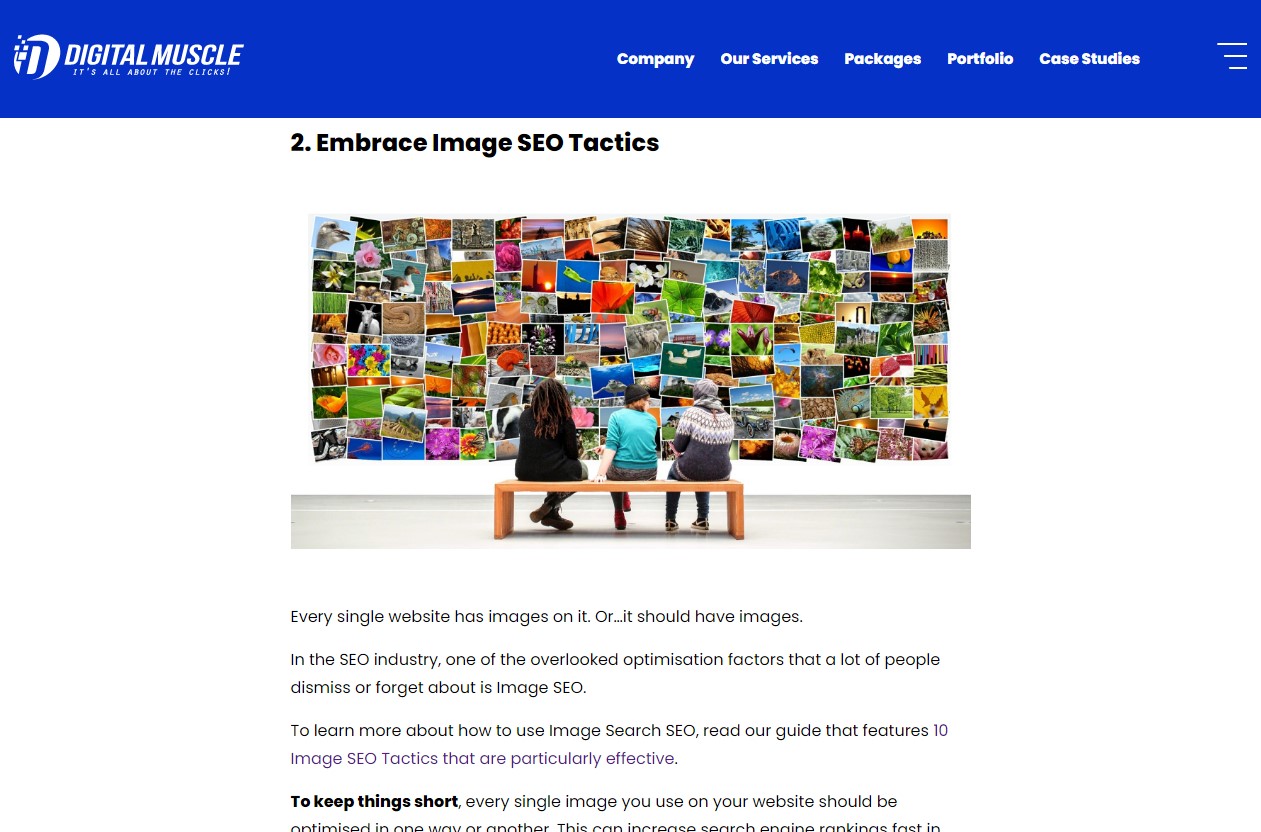
Let’s just think about the context of a blog. Most blogs have a sidebar, but it is filled with ads, award emblems, offers, and many other completely irrelevant things.
If the sidebar you use on the website does not add value to the content, it is better to just remove it. This would make it easier for the reader to focus on the most important part of the message you try to convey.
An example of proper use of the sidebar, which can reduce bounce rate, is to have a sticky section always visible above the fold that features related article recommendations. If those articles expand on what is written in the blog post, it adds useful and valuable content to the page.
Conclusions
Straight from the title, we highlighted the fact that bounce rate is the most underrated ranking factor in Google. This can be confusing for many because we are talking about an unofficial ranking factor, an indirect one.
How bounce rate affects your rankings is tightly connected to time spent on the website, which is usually more important. However, if you neglect bounce rate, you are faced with a huge problem because you might miss out on KEY user improvement necessities.
To keep it as simple as possible, always try to make your bounce rate as low as possible but do not neglect all the other things we highlight above.
First, see if your bounce rate needs to be lowered or it is normal for it to be higher. Then, see what you can do to reduce it, IF needed.
If you need professional help, get in touch. We will be more than happy to help you reduce bounce rates AND improve the quality of all the SEO work done on your site.






